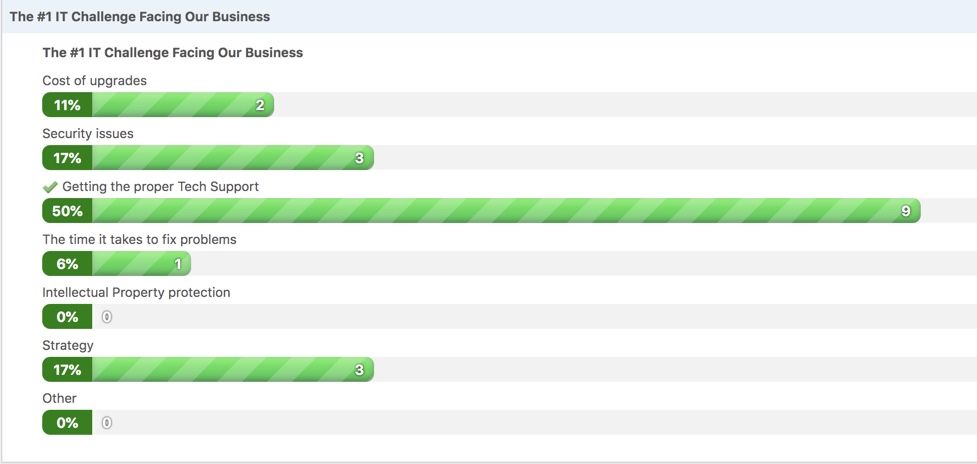Saying the future is uncertain would be an understatement.
As recent black swan events such as the Coronavirus outbreak and the Russian-Saudi oil price war has shown us, the only constant is constant change. While black swan events are unpredictable, there are macroeconomic trends and challenges that can be planned for. Many of the effects of black swan events only serve to accelerate existing trendlines. With that in mind, the following are the 5 biggest challenges facing your business today.
5 Biggest Challenges Facing Your Business Today
Post COVID-19
1. The transition to remote working
If recent events have taught us anything, it’s that we need to figure out how to continue working even when circumstances prevent us from physically being present in the office or on the factory floor. Remote work is a massive challenge that has not been solved in all industries and all market segments equally.
While many jobs in the information and services sectors can be accomplished from a home office, many more occupations, such as cashiers, nurses, and factory workers, cannot be. This is a serious challenge that is facing businesses from the restaurant sector to retailers to manufacturers and beyond. Even businesses with employees who could work remotely, in theory, are still struggling to adapt to a new normal of virtual conference calls and digital communication.
2. Effective digital communication and marketing

The future is digital.
Sure, print advertisements and other analog forms of communication will always occupy a small niche in the advertising and communication space. However, if your desire is to get in front of active consumers and prospective customers, you have to be visible. According to MarketWatch, Americans spend most of their waking hours staring at screens. These can be computers, tablets, televisions, and especially, our phones.
Recent world developments will only accelerate the reality that people don’t read books, magazines, and newspapers anymore. Instead, they interact with the world through digital mediums.
To communicate effectively today, companies need to get their message into these digital mediums and platforms. A majority of businesses are aware of the necessity of an effective digital communication and marketing strategy. The challenge going forward, however, is how to craft and implement an effective digital strategy.
Knowing you need a digital communication plan, and actually executing an effective digital strategy are two totally different things. Most people, for example, understand the need for a web presence in the form of a website. However, what you might not know is that consumers also expect your webpage to load in 2 seconds or less. Any slower than 2 seconds and impatient consumers will simply go elsewhere. Crafting an effective digital communication strategy might mean tooling your business’s IT infrastructure to deliver the experience consumers want and expect. Or, it might mean designing a lightweight and readable webpage.
This arms race towards greater and greater digital integration and convenience will be a huge potential hurdle for all businesses, even well-resourced corporations, going forward.
3. Shifting consumer behaviors

In the world of business, the only constant is constant change.
Nowhere is this more pronounced than in the way consumers behave. Even in relatively normal times, consumers are notorious for their fickleness. Unfortunately, these are not normal times. Numerous factors, including accelerating digitization and a global pandemic, are completely transforming market landscapes even as you read this article.
Shifting consumer attitudes as a result of new trends will force businesses to adapt and respond in real-time. Just look at the so-called fast fashion industry’s success in an era where most brick and mortar department stores are rapidly failing and closing their doors.
Despite the global dominance of e-commerce giants, such as Amazon and eBay, fast fashion retailers have carved out a lucrative market niche by organizing their core business around rapid adoption, adaption, and near real-time responsiveness to shifting consumer preferences. The challenge for businesses outside the fashion industry is to figure out a way to do the exact same thing in their respective industries. Like the failing retailers of yesteryear, companies that can’t keep up with the rapidly changing behaviors of their customers won’t last long in today’s world.
4. Supply chain disruptions

Companies are more connected to each other than ever before.
Disruptions to global supply and value chains, such as the ongoing COVID-19 pandemic, are exposing the fragile nature of these relationships. This is particularly pertinent for medium-sized and large companies that rely on intermediary suppliers for crucial parts, components, and services.
According to a report by Deloitte, many firms “rely on imported intermediate inputs from China and other countries affected by the disease.” Many of these companies also rely heavily on sales in China to meet financial goals. With so many businesses’ supply chains integrally tied to a single geographic location, in this case, China, any disruptions to that supply chain chokepoint can have dire consequences for American companies down the line.
One of the biggest challenges facing businesses today is how to diversify their supply chains. This may include rethinking where to source specific materials, parts, or labor, to avoid a complete shutdown if one part of their logistics network gets knocked out.
5. The right IT Support Strategy

Of the 5 major challenges facing your business today, identifying and executing the right information technology, or IT strategy is perhaps the most important.
Developing the right IT support strategy can go a long way towards addressing and mitigating remote working challenges, communication hurdles, shifting consumer behaviors, and supply chain disruptions. However, failing to implement the right IT strategy could exacerbate all of those major issues. Without an effective IT support plan, companies are flying blind into an impending storm.
According to a recent Wright Business Technologies poll, half of the surveyed companies said that “getting the proper tech support” was their number one concern. That’s on top of 17% of respondents who said that “cybersecurity issues” were also a top concern and 11% who cited the “cost of upgrades” as another major challenge facing their business today.


